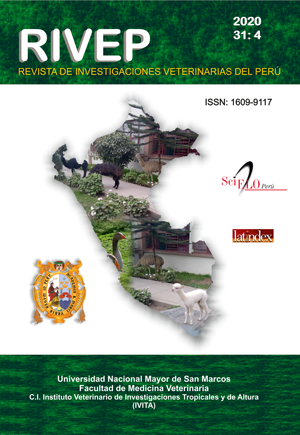Animal welfare indicators in dairy cows in a silvopastoril system of the high Colombian tropic
DOI:
https://doi.org/10.15381/rivep.v31i4.16871Keywords:
Haematobia irritans, silvopastoral, animal welfare, comfortAbstract
In the municipality of Saboyá, Boyacá, Colombia, the number of Haematobia irritans flies, coat temperature, respiratory rate, motor activity, flight distance, level of dirt and occurrence of subclinical mastitis were evaluated as indicators of animal welfare in Holstein cows reared in a silvopastoral system (association of Cenchrus clandestinus and Alnus acuminata) and a traditional system based on grazing C. clandestinus in monoculture. Monthly samplings were carried out between August 2015 and May 2016 in 20-30 lactating cows selected at random in each farm. The data were analyzed using generalized linear regression models. The number of flies per animal was higher (p<0.05) in the traditional system compared to the silvopastoral system (56 ± 47.5 and 44 ± 40.0 flies/animal, respectively); the average coat temperature in the animals of the traditional system was 37.4 ºC, while 33.8 ºC in the silvopastoral system (p<0.05). There were no differences in respiratory rate. Cows had higher feed intake during the first hours of the day in both systems. The creepage distance and level of dirt were lower in the silvopastoral system (p<0.05), while the percentages of subclinical mastitis were similar between the two systems. Silvopastoral systems favour the expression of animal welfare indicators due to the presence of trees in paddocks, which offer diversification of the ecosystem and generate better conditions for the permanence of cows in grazing.
Downloads
Downloads
Published
Issue
Section
License
Copyright (c) 2020 Aldemar Zúñiga López, Andrés Camilo Rodriguez Serrano, Juan Carlos Benavides Cruz, Catalina Medrano Galarza, Fredy Enrique García Castro

This work is licensed under a Creative Commons Attribution-NonCommercial-ShareAlike 4.0 International License.
AUTHORS RETAIN THEIR RIGHTS:
a. Authors retain their trade mark rights and patent, and also on any process or procedure described in the article.
b. Authors retain their right to share, copy, distribute, perform and publicly communicate their article (eg, to place their article in an institutional repository or publish it in a book), with an acknowledgment of its initial publication in the Revista de Investigaciones Veterinarias del Perú (RIVEP).
c. Authors retain theirs right to make a subsequent publication of their work, to use the article or any part thereof (eg a compilation of his papers, lecture notes, thesis, or a book), always indicating the source of publication (the originator of the work, journal, volume, number and date).



